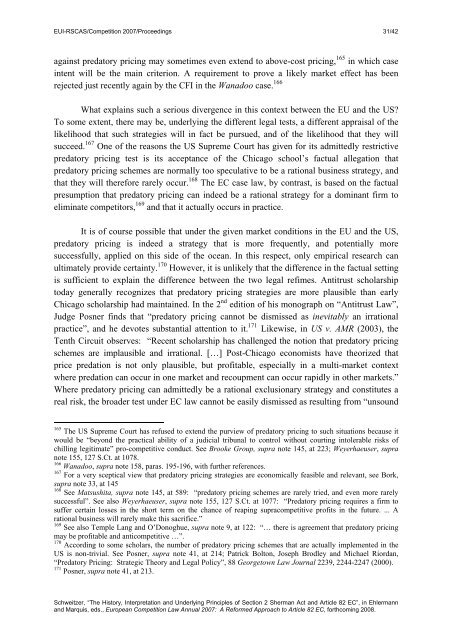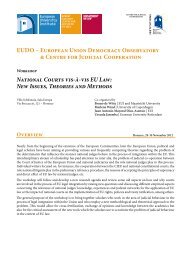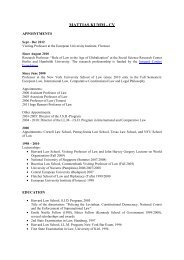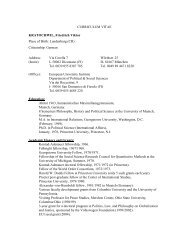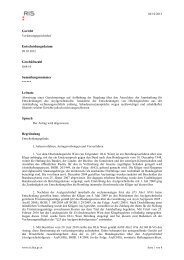The History, Interpretation and Underlying Principles of Section
The History, Interpretation and Underlying Principles of Section
The History, Interpretation and Underlying Principles of Section
You also want an ePaper? Increase the reach of your titles
YUMPU automatically turns print PDFs into web optimized ePapers that Google loves.
EUI-RSCAS/Competition 2007/Proceedings 31/42<br />
against predatory pricing may sometimes even extend to above-cost pricing, 165 in which case<br />
intent will be the main criterion. A requirement to prove a likely market effect has been<br />
rejected just recently again by the CFI in the Wanadoo case. 166<br />
What explains such a serious divergence in this context between the EU <strong>and</strong> the US?<br />
To some extent, there may be, underlying the different legal tests, a different appraisal <strong>of</strong> the<br />
likelihood that such strategies will in fact be pursued, <strong>and</strong> <strong>of</strong> the likelihood that they will<br />
succeed. 167 One <strong>of</strong> the reasons the US Supreme Court has given for its admittedly restrictive<br />
predatory pricing test is its acceptance <strong>of</strong> the Chicago school’s factual allegation that<br />
predatory pricing schemes are normally too speculative to be a rational business strategy, <strong>and</strong><br />
that they will therefore rarely occur. 168 <strong>The</strong> EC case law, by contrast, is based on the factual<br />
presumption that predatory pricing can indeed be a rational strategy for a dominant firm to<br />
eliminate competitors, 169 <strong>and</strong> that it actually occurs in practice.<br />
It is <strong>of</strong> course possible that under the given market conditions in the EU <strong>and</strong> the US,<br />
predatory pricing is indeed a strategy that is more frequently, <strong>and</strong> potentially more<br />
successfully, applied on this side <strong>of</strong> the ocean. In this respect, only empirical research can<br />
ultimately provide certainty. 170 However, it is unlikely that the difference in the factual setting<br />
is sufficient to explain the difference between the two legal refimes. Antitrust scholarship<br />
today generally recognizes that predatory pricing strategies are more plausible than early<br />
Chicago scholarship had maintained. In the 2 nd edition <strong>of</strong> his monograph on “Antitrust Law”,<br />
Judge Posner finds that “predatory pricing cannot be dismissed as inevitably an irrational<br />
practice”, <strong>and</strong> he devotes substantial attention to it. 171 Likewise, in US v. AMR (2003), the<br />
Tenth Circuit observes: “Recent scholarship has challenged the notion that predatory pricing<br />
schemes are implausible <strong>and</strong> irrational. […] Post-Chicago economists have theorized that<br />
price predation is not only plausible, but pr<strong>of</strong>itable, especially in a multi-market context<br />
where predation can occur in one market <strong>and</strong> recoupment can occur rapidly in other markets.”<br />
Where predatory pricing can admittedly be a rational exclusionary strategy <strong>and</strong> constitutes a<br />
real risk, the broader test under EC law cannot be easily dismissed as resulting from “unsound<br />
165 <strong>The</strong> US Supreme Court has refused to extend the purview <strong>of</strong> predatory pricing to such situations because it<br />
would be “beyond the practical ability <strong>of</strong> a judicial tribunal to control without courting intolerable risks <strong>of</strong><br />
chilling legitimate” pro-competitive conduct. See Brooke Group, supra note 145, at 223; Weyerhaeuser, supra<br />
note 155, 127 S.Ct. at 1078.<br />
166 Wanadoo, supra note 158, paras. 195-196, with further references.<br />
167 For a very sceptical view that predatory pricing strategies are economically feasible <strong>and</strong> relevant, see Bork,<br />
supra note 33, at 145<br />
168 See Matsushita, supra note 145, at 589: “predatory pricing schemes are rarely tried, <strong>and</strong> even more rarely<br />
successful”. See also Weyerhaeuser, supra note 155, 127 S.Ct. at 1077: “Predatory pricing requires a firm to<br />
suffer certain losses in the short term on the chance <strong>of</strong> reaping supracompetitive pr<strong>of</strong>its in the future. ... A<br />
rational business will rarely make this sacrifice.”<br />
169 See also Temple Lang <strong>and</strong> O’Donoghue, supra note 9, at 122: “… there is agreement that predatory pricing<br />
may be pr<strong>of</strong>itable <strong>and</strong> anticompetitive …”.<br />
170 According to some scholars, the number <strong>of</strong> predatory pricing schemes that are actually implemented in the<br />
US is non-trivial. See Posner, supra note 41, at 214; Patrick Bolton, Joseph Brodley <strong>and</strong> Michael Riordan,<br />
“Predatory Pricing: Strategic <strong>The</strong>ory <strong>and</strong> Legal Policy”, 88 Georgetown Law Journal 2239, 2244-2247 (2000).<br />
171 Posner, supra note 41, at 213.<br />
Schweitzer, “<strong>The</strong> <strong>History</strong>, <strong>Interpretation</strong> <strong>and</strong> <strong>Underlying</strong> <strong>Principles</strong> <strong>of</strong> <strong>Section</strong> 2 Sherman Act <strong>and</strong> Article 82 EC”, in Ehlermann<br />
<strong>and</strong> Marquis, eds., European Competition Law Annual 2007: A Reformed Approach to Article 82 EC, forthcoming 2008.


